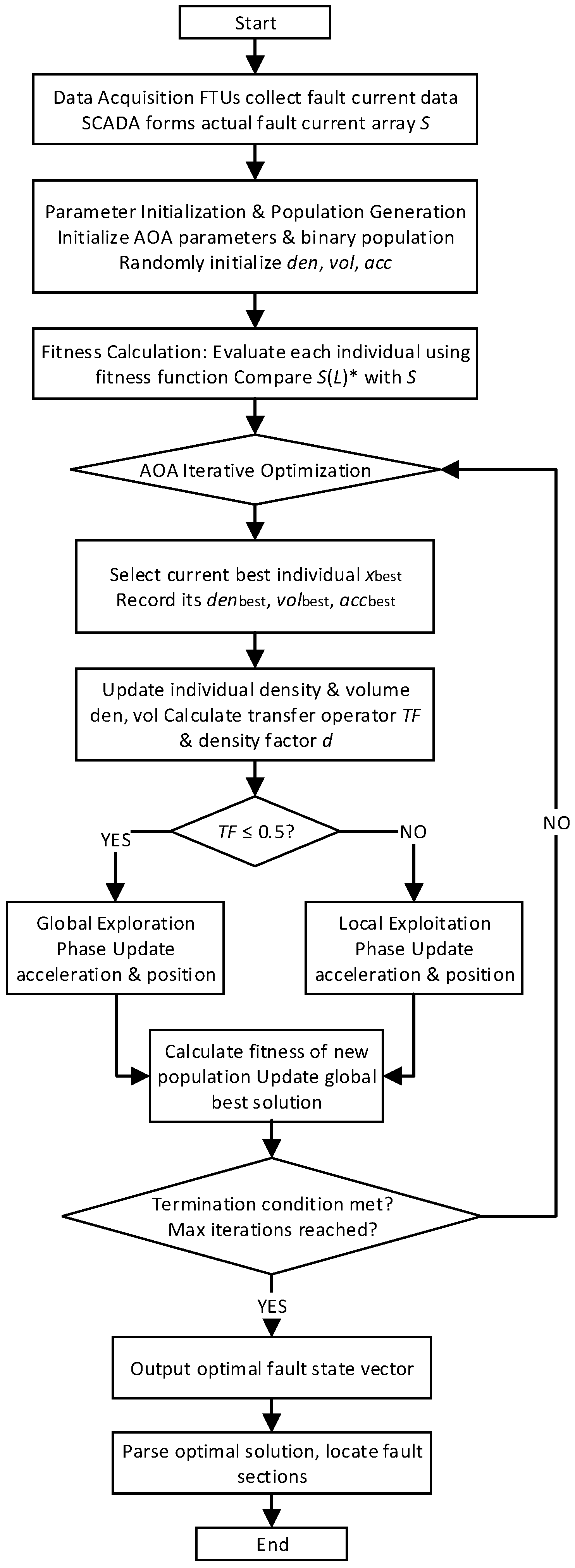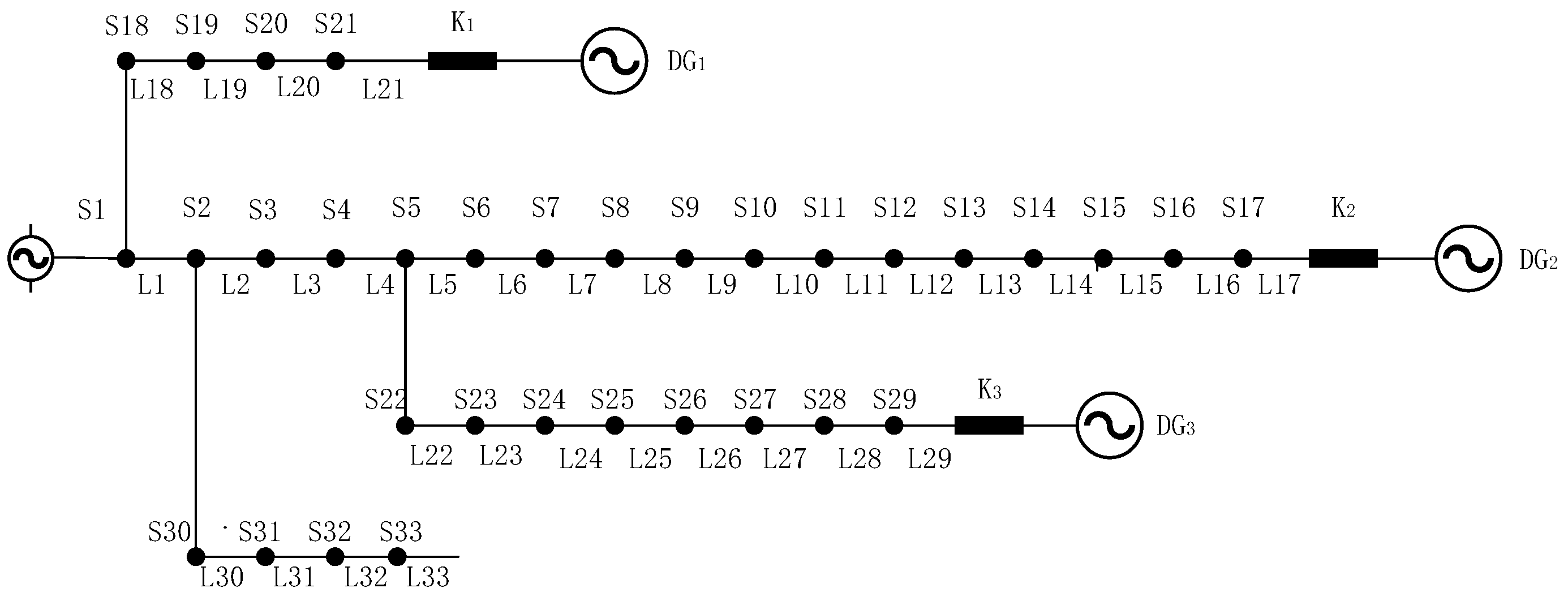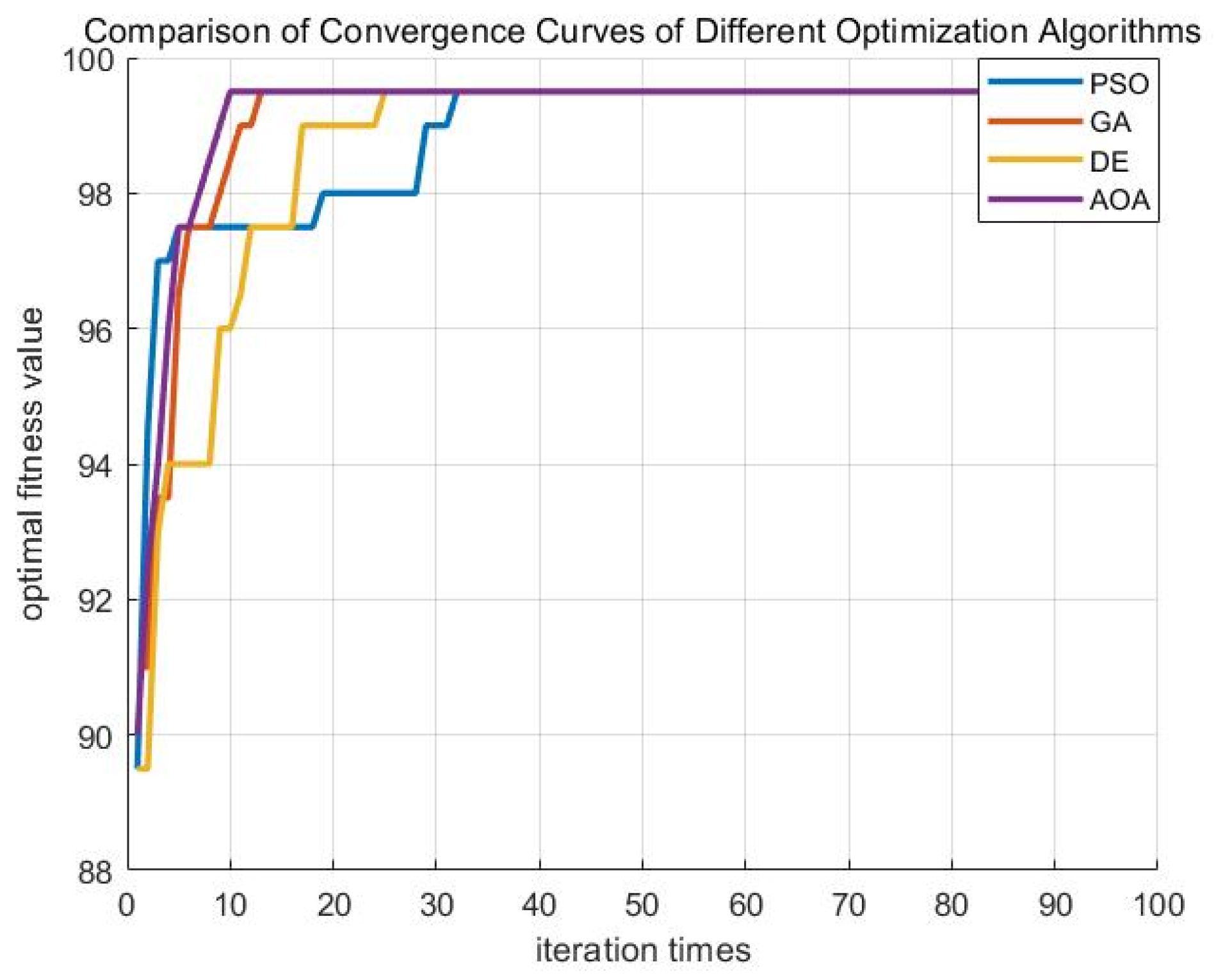Research on Fault Location Method of Distribution Network Based on Archimedes Optimization Algorithm
Abstract
1. Introduction
2. Archimedes Optimization Algorithm
- (1)
- In the initialization phase, AOA initializes the population position as shown in Equation (1):
- (2)
- Global exploration phase (collisions between objects)
- (3)
- Local exploitation phase (no collisions between objects)
3. Fault Location Process Based on AOA for Distribution Networks
3.1. Binary Discrete Improvement
- (1)
- In the exploration phase, for each dimension, the algorithm decides whether to flip the current binary value (i.e., changing 0 to 1 or 1 to 0) based on a calculated probability.
- (2)
- In the exploitation phase, based on the value of parameter p, the algorithm sets the value of the current dimension to either the corresponding value of the global best solution or its flipped version, according to a specified probability.
3.2. Fitness Function Design
3.3. Algorithm Location Process
- (1)
- Data collection: FTU devices collect fault current state information of components such as sectionalizing switches, tie switches, and circuit breakers, uploading it to the master SCADA system. Based on the number of nodes, the actual fault current array Si of switch nodes is generated.
- (2)
- Parameter initialization and population generation: Initialize the population size, maximum iteration count Tmax, variable dimension (number of feeder sections), and adaptive parameters C1 = 2.5, C2 = 4.0, C3 = 1.0, C4 = 2.0; generate the initial binary population, where each individual represents a set of fault operation states for the feeder sections; randomly initialize the density (den), volume (vol), and acceleration (acc).
- (3)
- Fitness evaluation: Calculate the fitness value for each binary individual according to the fitness function described in Equation (12). This evaluates the degree of agreement between the corresponding expected fault current state array information S(L)* and the actual fault current state array information S.
- (4)
- AOA iterative optimization: First, select the individual with the highest fitness in the current population as xbest, and record its denbest, volbest, and accbest. Then, update the density and volume of individuals using Equation (3), calculate TF and d using Equation (4). Subsequently, perform global exploration and local exploitation to update the population positions. Calculate the fitness of the new population and update the global best solution.
- (5)
- Termination check and result output: If the termination criteria are met (the maximum iteration count is reached), output the optimal fault state vector.
3.4. Computational Complexity Analysis
4. Simulation Experiments and Result Analysis
- (1)
- Single-point fault
- (2)
- Multi-point fault
5. Conclusions
Author Contributions
Funding
Data Availability Statement
Conflicts of Interest
References
- Hu, B.A.; Liu, Y.B.; Xu, L.X. Solution of reliability value-added service based on two-level game model considering distribution system reconfiguration strategy. Proc. CSEE 2023, 43, 9496–9509. [Google Scholar] [CrossRef]
- Zhang, B.; Gao, Y.; Wang, L. Reactive voltage control strategy of distribution network considering the reliability of photovoltaic power supply. High Volt. Eng. 2023, 49, 2775–2784. [Google Scholar] [CrossRef]
- Xiang, Y.; Qin, L.; Tan, T.Y. Power quality characteristics analysis and research progress of AC/DC distribution networks. Power Syst. Technol. 2025, 49, 1585–1605. [Google Scholar] [CrossRef]
- Zhao, Y.; Li, Q.; Zhang, Y.X. Optimal configuration of hybrid energy storage considering power supply reliability in distribution network with distributed energy. Smart Power 2024, 52, 25–32+49. [Google Scholar]
- He, X.L.; Gao, H.J.; Huang, Y. Fault section location for a distribution network based on one-dimensional convolution and graph neural networks. Power Syst. Prot. Control 2024, 52, 27–39. [Google Scholar] [CrossRef]
- Liu, X.M.; Feng, Z.H.; Chen, H. Transient analysis of short-circuit faults in DC distribution network with distributed generations. Proc. CSU-EPSA 2024, 36, 149–158. [Google Scholar] [CrossRef]
- Mei, F.; Chen, Z.P.; Pei, X. Fault-tolerant method for fault location of active distribution network based on matrix algorithm. Electr. Power Eng. Technol. 2022, 41, 109–115. [Google Scholar]
- Galvez, C.; Abur, A. Fault location in active distribution networks containing distributed energy resources (DERs). IEEE Trans. Power Deliv. 2021, 36, 3128–3139. [Google Scholar] [CrossRef]
- Liang, Y.D.; Tian, S.; Liu, M.H. Fault section location of multi-source distribution network based on phasor correction. Power Syst. Prot. Control 2023, 51, 33–42. [Google Scholar] [CrossRef]
- Wang, Z.T.; Luo, Y.; Lu, X.J. Fault detection of rare earth production line based on Bayesian secondary discrimination. J. Guilin Univ. Electron. Technol. 2021, 41, 420–425. [Google Scholar] [CrossRef]
- Zhang, Z.L.; Gao, Y.; Pan, Q. Research on state estimation algorithm of distribution network based on genetic algorithm. In Proceedings of the 2024 IEEE 7th International Conference on Automation, Electronics and Electrical Engineering (AUTEEE), Shenyang, China, 27–29 December 2024. [Google Scholar] [CrossRef]
- Qin, J.; Chu, H.B.; Yu, D.Q. Transmission line fault diagnosis and location system in distribution network based on PSO. In Proceedings of the 2023 2nd International Conference for Innovation in Technology (INOCON), Bangalore, India, 3–5 March 2023. [Google Scholar] [CrossRef]
- Haleem, A.M.I.; Sharma, M.; Sajan, K.S. A comparative review of fault location/identification methods in distribution networks. In Proceedings of the 2018 1st International Conference on Advanced Research in Engineering Sciences (ARES), Dubai, United Arab Emirates, 15 June 2018. [Google Scholar] [CrossRef]
- Dong, X.F.; Zhu, Y.Y.; Wang, Q.H. Regional fault location and fault tolerance analysis of distribution network based on genetic algorithm. Chin. J. Constr. Mach. 2023, 21, 607–612. [Google Scholar] [CrossRef]
- Gao, D.H. Fault location analysis of distribution network based on particle swarm optimization algorithm. Lamps Light. 2024, 1, 89–91. [Google Scholar]
- Zhao, Q.; Wang, Z.P.; Dong, W.N. Research on fault location in a distribution network based on an immunebinary particle swarm algorithm. Power Syst. Prot. Control 2020, 48, 83–89. [Google Scholar] [CrossRef]
- Guo, Z.Z.; Wu, J.K. Electromagnetism-like mechanism based fault section diagnosis for distribution network. Proc. CSEE 2010, 30, 34–40. [Google Scholar] [CrossRef]
- He, J.; Zhou, S.J.; Li, K.C. Study on fault location of distribution network based on beetle colony antennae search algorithm. Power Capacit. React. Power Compens. 2021, 42, 92–97. [Google Scholar] [CrossRef]
- Zou, Y.Q.; Li, R.; Li, Z.M. Research on distribution network fault location based on optimal individual ant colony algorithm. Electr. Drive Autom. 2018, 40, 58–62. [Google Scholar]
- Zhang, L.; Zhang, S.D.; Jia, H. Fault section location of distribution network based on an improved whale algorithm algorithm. Zhejiang Electr. Power 2022, 41, 63–70. [Google Scholar] [CrossRef]
- Wu, X.M.; Han, K.; Dang, B. Fault section location method for active distribution network based on improved sparrow algorithm. Sci. Technol. Eng. 2025, 25, 12059–12067. [Google Scholar]
- Shang, L.; Li, Z. Research on fault location method of active distribution network based on improved multiverse algorithm. J. Phys. Conf. Ser. 2024, 2814, 012060. [Google Scholar] [CrossRef]
- Hashim, F.A.; Hussain, K.; Houssein, E.H. Archimedes optimization algorithm: A new metaheuristic algorithm for solving optimization problems. Appl. Intell. 2021, 51, 1531–1551. [Google Scholar] [CrossRef]
- Wang, J.W.; Yue, Y.T.; Li, B.H. Optimization of microgrid based on archimedes chaotic elite whale algorithm. Sci. Technol. Eng. 2023, 23, 12577–12584. [Google Scholar]
- Adegoke, S.A.; Sun, Y.X.; Wang, Z.H. Application of archimedes optimization algorithm for network reconfiguration to minimize power loss and voltage deviation. In Proceedings of the 2024 6th International Conference on Power and Energy Technology (ICPET), Beijing, China, 12–15 July 2024. [Google Scholar]




| Fault Current Information | Encoding Scheme for Actual Fault Current Array Si of Switch Nodes | |
|---|---|---|
| No fault current or undetectable | 0 | 0 |
| With fault current | Same as defined positive direction | 1 |
| Opposite to defined positive direction | −1 | |
| [K1, K2, K3] | Fault Section | FTU-Reported Information | Positioning Output Results | Location Results |
|---|---|---|---|---|
| [0, 0, 0] | L11 | [1, 1, 1, 1, 0, 0, 0, 0, 0, 0, 0, 0, 0, 0, 0, 0, 0,0, 0, 0, 0, 0, 0, 0, 0, 0, 0, 0, 0, 0, 0, 0, 0] | [0, 0, 0, 0, 0, 0, 0, 0, 0, 0, 1, 0, 0, 0, 0, 0, 0,0, 0, 0, 0, 0, 0, 0, 0, 0, 0, 0, 0, 0, 0, 0, 0] | L11 |
| [0, 1, 0] | L19 | [1, 1, −1, −1, −1, −1, −1, −1, −1, −1, −1, −1, −1, −1, −1,−1, −1, 1, 1, 0, 0, 0, 0, 0, 0, 0, 0, 0, 0, 0, 0, 0, 0] | [0, 0, 0, 0, 0, 0, 0, 0, 0, 0, 0, 0, 0, 0, 0, 0, 0,0, 1, 0, 0, 0, 0, 0, 0, 0, 0, 0, 0, 0, 0, 0, 0] | L19 |
| [1, 1, 0] | L9 | [1, 1, 1, 1, 1, 1, 1, 1, 1, −1, −1, −1, −1, −1, −1, −1, −1,−1, −1, −1, −1, 0, 0, 0, 0, 0, 0, 0, 0, 0, 0, 0, 0] | [0, 0, 0, 0, 0, 0, 0, 0, 1, 0, 0, 0, 0, 0, 0, 0, 0,0, 0, 0, 0, 0, 0, 0, 0, 0, 0, 0, 0, 0, 0, 0, 0] | L9 |
| [1, 1, 1] | L28 | [1, 1, 1, 1, 1, −1, −1, −1, −1, −1, −1, −1, −1, −1, −1, −1,−1, −1, −1, −1, −1, 1, 1, 1, 1, 1, 1, 1, −1, 0, 0, 0, 0] | [0, 0, 0, 0, 0, 0, 0, 0, 0, 0, 0, 0, 0, 0, 0, 0, 0,0, 0, 0, 0, 0, 0, 0, 0, 0, 0, 1, 0, 0, 0, 0, 0] | L28 |
| The Comparison Algorithm | Location Accuracy/% | Mean Convergence Generations | Iteration Time/s |
|---|---|---|---|
| AOA | 96.67 | 7 | 0.520 |
| PSO | 63.33 | 17 | 0.669 |
| GA | 90.00 | 11 | 0.546 |
| DE | 83.33 | 15 | 0.562 |
| [K1, K2, K3] | Fault Section | FTU-Reported Information | Positioning Output Results | Location Results |
|---|---|---|---|---|
| [0, 0, 0] | L8, L19, L25 | [1, 1, 1, 1, 1, 1, 1, 1, 0, 0, 0, 0, 0, 0, 0, 0, 0, 1, 1, 0, 0, 1, 1, 1, 1, 0, 0, 0, 0, 1, 1, 1, 1] | [0, 0, 0, 0, 0, 0, 0, 1, 0, 0, 0, 0, 0, 0, 0, 0, 0, 0, 1, 0, 0, 0, 0, 0, 1, 0, 0, 0, 0, 0, 0, 0, 0] | L8, L19, L25 |
| [0, 1, 0] | L14, L20, L31 | [1, 1, 1, 1, 1, 1, 1, 1, 1, 1, 1, 1, 1, 1, −1, −1, −1, 1, 1, 1, 0, 0, 0, 0, 0, 0, 0, 0, 0, 1, 1, 0, 0] | [0, 0, 0, 0, 0, 0, 0, 0, 0, 0, 0, 0, 0, 1, 0, 0, 0, 0, 0, 1, 0, 0, 0, 0, 0, 0, 0, 0, 0, 0, 1, 0, 0] | L14, L20, L31 |
| [1, 1, 0] | L9, L20, L31 | [1, 1, 1, 1, 1, 1, 1, 1, 1, 0, 0, 0, 0, 0, 0, 0, 0, 1, 1, 1, −1, −1, −1, −1, −1, −1, −1, −1, −1, 1, 1, 0, 0] | [0, 0, 0, 0, 0, 0, 0, 0, 1, 0, 0, 0, 0, 0, 0, 0, 0, 0, 0, 1, 0, 0, 0, 0, 0, 0, 0, 0, 0, 0, 1, 0,0] | L9, L20, L31 |
| [1, 1, 1] | L10, L28, L32 | [1, 1, 1, 1, 1, 1, 1, 1, 1, 1, −1, −1, −1, −1, −1, −1, −1, −1, −1, −1, −1, 1, 1, 1, 1, 1, 1, 1, −1, 1, 1, 1, 0] | [0, 0, 0, 0, 0, 0, 0, 0, 0, 1, 0, 0, 0, 0, 0, 0, 0, 0, 0, 0, 0, 0, 0, 0, 0, 0, 0, 1, 0, 0, 0, 1, 0] | L10, L28, L32 |
| The Comparison Algorithm | Location Accuracy/% | Mean Convergence Generations | Iteration Time/s |
|---|---|---|---|
| AOA | 97.78 | 6 | 0.519 |
| PSO | 82.22 | 13 | 0.663 |
| GA | 91.11 | 9 | 0.534 |
| DE | 87.78 | 12 | 0.566 |
Disclaimer/Publisher’s Note: The statements, opinions and data contained in all publications are solely those of the individual author(s) and contributor(s) and not of MDPI and/or the editor(s). MDPI and/or the editor(s) disclaim responsibility for any injury to people or property resulting from any ideas, methods, instructions or products referred to in the content. |
© 2025 by the authors. Licensee MDPI, Basel, Switzerland. This article is an open access article distributed under the terms and conditions of the Creative Commons Attribution (CC BY) license (https://creativecommons.org/licenses/by/4.0/).
Share and Cite
Zhang, J.; Zhang, H.; Lin, R.; Zhou, S.; Yan, J.; Li, J.; Zhang, F. Research on Fault Location Method of Distribution Network Based on Archimedes Optimization Algorithm. Processes 2025, 13, 3715. https://doi.org/10.3390/pr13113715
Zhang J, Zhang H, Lin R, Zhou S, Yan J, Li J, Zhang F. Research on Fault Location Method of Distribution Network Based on Archimedes Optimization Algorithm. Processes. 2025; 13(11):3715. https://doi.org/10.3390/pr13113715
Chicago/Turabian StyleZhang, Jiajun, Haifeng Zhang, Runzi Lin, Shuyu Zhou, Jing Yan, Juan Li, and Fang Zhang. 2025. "Research on Fault Location Method of Distribution Network Based on Archimedes Optimization Algorithm" Processes 13, no. 11: 3715. https://doi.org/10.3390/pr13113715
APA StyleZhang, J., Zhang, H., Lin, R., Zhou, S., Yan, J., Li, J., & Zhang, F. (2025). Research on Fault Location Method of Distribution Network Based on Archimedes Optimization Algorithm. Processes, 13(11), 3715. https://doi.org/10.3390/pr13113715





